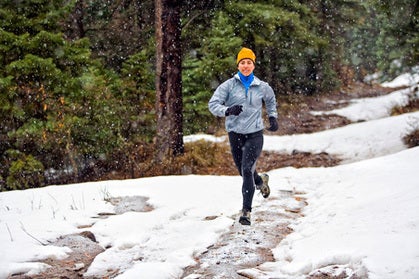Become One with the Cold

Trail running just gets good with the plummeting temps and slippery slush
Photo by Michael DeYoung
When the mercury shrinks and snow piles up, you don’t have to exchange your beloved trail shoes for clunky skis or snowshoes. Look at winter as an opportunity to experience our sport in a completely fresh way. And be comfortable and have fun doing it.
Fresh Tracks
If you live in snow country, winter may shut down your favorite backcountry trails to running, but opens a reason to rethink your definition of a quality “trail.” Those closer-to-town, heavily trafficked summer trails, for example, take on an altogether new personality, when fair-weather trail users flock to the coffee shops. Look for hiker-packed trails, which can offer a dreamy, cushioned running surface, one that may even seem easier to run than in the summer as the rocks and rough spots get filled in.
“I find running in winter a great time to rediscover why we do what we do—it’s all about play,” says Barry Lewis, of Philadelphia, Pennsylvania, a long-time East Coast trail runner and racer. “The trails might be icy, muddy or covered in snow—sometimes it’s all of the above in a single run—and thoughts of speed and mileage give way to the joy of exploring whatever’s ahead.”
Dress Up
When your windowpanes are framed in ice, it’s natural to bundle up, but avoid overdressing. The key is covering all the body parts minimally, and, as per all active outdoor endeavors, allowing for shedding or adding lightweight, non-bulky layers.
For temps around freezing, a basic running kit consists of tights, short-sleeve wicking top, long-sleeve wicking top, a windbreaker or light rain jacket, cap or light wool or synthetic hat, fleece gloves, socks and shoes. If the temps are frigid and/or the wind is whipping, consider adding a light, wind-cutting vest and pants. Gore-Tex shoes shine this time of year, providing protection from slush and snow and added warmth.
Thin to medium wool socks provide warmth and comfort in snow, especially when combined with a lightweight gaiter (e.g. REI’s Trail Running Gaiter). Other accessories might include a light facemask, neck gaiter (e.g. www.buff.us) and inov-8’s Debris Sock.
To avoid the chilling effects of a heavy sweat, start out feeling a little cold, because you’ll quickly warm. Remember to shed or add layers before you overheat or freeze, respectively.
Hydration is just as critical in winter as summer, but comes with its challenges when temps dip below the freezing mark. Bladder hoses can freeze faster than a Usain Bolt 100-meter race time. So look for insulated bladder-hose systems.
Ice Is Nice
Like driving your car on black ice, running on packed snow and ice requires extra traction, and there are three commonly used options. Pull-on/strap-on devices (e.g. 32north STABILicers SPORT, Yaktrax Pro and Kahtoola MICROspikes) work well, although they are bulky.
A simple, foolproof system is La Sportiva’s Hobnails (www.sportiva.com), basically a set of screws that you install (tool included) into your shoe’s outsole. Also, check out the tried-and-true Screw Shoe method on Matt Carpenter’s website (www.skyrunner.com/screwshoe.htm), which involves screwing sheet-metal screws into your outsoles.
And the simplest of all options are the Swedish-made Icebug shoes (www.garmontusa.com/icebug.html)—winterized running shoes with cleats in the outsole lugs.
In Balance
Aside from investing in some sort of shoe cleat, increase your chances of keeping the rubber side down by shortening your stride to better stay balanced over your feet. In doing so, you may also receive the benefits of increased turnover. As counter-intuitive as it may feel, stay over your feet on downhills and avoid a leaning-back, braking stride. Or else on ice you’ll go down, hard. Also, relax and look ahead to anticipate obstacles.
“The key to running on snow is to pretend you are levitating and stay super light on your feet,” says Karl Meltzer of Salt Lake City, Utah, winner of more 100-milers than anyone else and previous ski-resort employee. “When running downhill on a slick trail, it’s important to let feet slide a little for maximum speed. Stay a little lower to the ground, and look for shoes with big knobbies.”
For the ultimate in stability, consider using trekking or Nordic-walking poles, which are becoming more popular in winter—and summer.